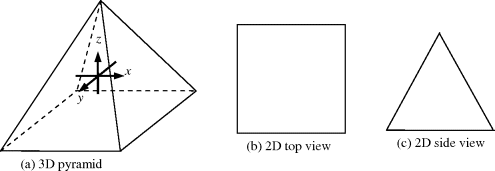31.4 Feature Dimensionality Expansion by Nonlinear Kernels
Unlike BDE, which expands band dimensionality to resolve the issue in use of an insufficient number of spectral bands, FDE makes a rather different attempt by expanding features used by classification to a high dimensional feature space via a nonlinear kernel so that the linear nonseparability issue arising in the original data space can be resolved in a new feature space. Its idea can be briefly illustrated by the following example. Assume that a three-dimensional (3D) pyramid shown in Figure 31.5(a) is viewed in a two-dimensional space. It must require two views, a 2D top view shown in Figure 31.5(b) and a 2D side view shown in Figure 31.5(c) to completely envision what a pyramid looks like in a 3D space.
Using the pyramid in Figure 31.4(a) as an example, solving a linear nonseparable problem in an original data space is similar to viewing a pyramid in a two-dimensional data space, which requires two different views, top and side views, to capture its shape, which can only be visualized in a three-dimensional space. This is equivalent to expanding two top and side views to a single view of a pyramid in a three-dimesnional space shown in Figure 31.4(a), which becomes linearly separable problem.
Figure 31.4 A three-dimensional pyramid can be viewed by jointly 2 two-dimensional top and side views.

Two kernel-based approaches ...
Get Hyperspectral Data Processing: Algorithm Design and Analysis now with the O’Reilly learning platform.
O’Reilly members experience books, live events, courses curated by job role, and more from O’Reilly and nearly 200 top publishers.

